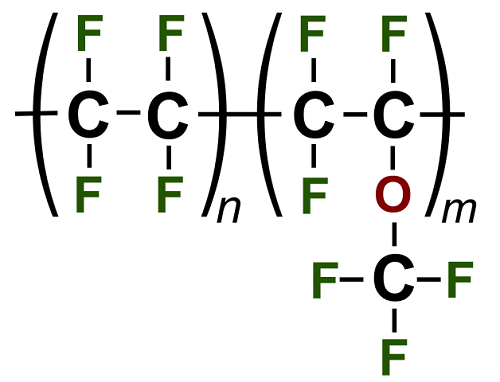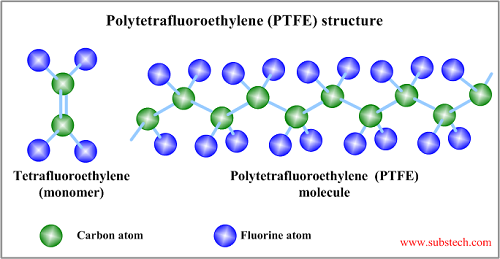Difference Between PFA and PTFE

PFA Structure
PFA vs. PTFE
Ask a man on the street what fluoropolymers are, and they’ll give you a blank stare or an expression that has all the indications that they think you are a “nerd” for asking such a technical question. But mention “Teflon,” and most people will know that it’s mostly used in frying pans for its “non-stick” qualities. What may come as a surprise is that Teflon isn’t the only form of fluoropolymer used in the world. There are actually several types available, though the most popular ones are produced by the same company – DuPont Co. Of those available on the market, the most common fluoropolymers are PFA and PTFE due to their unique qualities and versatility.
PFA, or Perfluoroalkoxy, is a type of fluoropolymer. It has very similar properties as the more common polytetrafluoroethylene (PTFE), which is the more popularly known form of Teflon. PFA was conceived by DuPont Co. and given the brand name Teflon PFA. What distinguishes it from the resins of PTFE is that PFA is melt processable. This is accomplished through conventional injection molding as well as screw extrusion techniques.
PFA is generally used for plastic lab equipment because of its optical transparency, overall flexibility, and extreme resistance to chemical attack. PFA is also often used as tubing for handling critical or highly corrosive processes. Other applications for PFA are as sheet linings for chemical equipment. Because of its properties, it can facilitate the use of carbon steel fiber reinforced plastics (FRPs) as replacements for more expensive alloys and metals.

PTFE structure
Polytetrafluoroethylene (PTFE), on the other hand, is also a synthetic fluoropolymer of tetrafluoroethylene. DuPont Co. is the best-known producer of PTFE, which, as mentioned before, is the material most people know as Teflon. Building from the accidental discovery of Roy Plunkett, PTFE is a high-molecular-weight compound comprised of carbon and fluorine. Essentially, it is a fluorocarbon solid. It is hydrophobic, meaning water or substances containing water can get it wet due to the fluorocarbon’s characteristic of having mitigated London dispersion forces. Thus, PTFE possesses a very low coefficient of friction when in contact with solids. This is due to the high electronegativity of fluorine. Other than Teflon, PTFE is also commonly called Fluon and Syncolon.
PTFE is popularly used as a non-stick coating for pans and many modern items of cookware. PTFE is often used in containers and pipes for handling reactive and corrosive chemicals; this is due to its non-reactive properties. Another practical application of PTFE is as a lubricant. Used in this way, PTFE helps reduce friction within machinery, minimizes the “wear and tear,” and improves energy consumption.
PFA is superior to PTFE in terms of flexibility, particularly when it comes to tubing applications. On the other hand, PFA’s flex life (i.e. capacity to endure repetitive folding) is lower than that of PTFE. PTFE is slightly more resistant to heat than PFA. PFA is more affected by water absorption and weathering but is superior to PTFE when it comes to salt spray resistance. The most significant quality of PFA over PTFE is its electrical properties. It possesses the dielectric constant of PTFE as well as a very similar dissipation factor; yet PFA has a dielectric strength three to four times higher than that of PTFE.
Teflon is one of the most significant inventions of the 20th century, having many applications, both practical and technical, in our modern world. It’s good to know there is more than one form, such as PFA and PTFE, which caters to specific needs and uses.
Summary:
1.Both PFA and PTFE are fluoropolymers.
2.DuPont sells and distributes both PFA and PTFE.
3.PTFE is the more commonly used fluoropolymer, and it is popularly known as “Teflon.”
4.PFA is melt processable and more versatile than PTFE, but PTFE is superior when it comes to being less water absorbent and resistant to weathering.
5.PFA is more often used in industrial applications, particularly with lab equipment and industrial tubing, but PTFE is more common and popular especially with cookware.
- Differences Between Fraternity And Sorority - January 8, 2014
- Differences Between Lucite and Plastic - January 7, 2014
- Differences Between Oil and Butter - January 6, 2014
Search DifferenceBetween.net :
3 Comments
Leave a Response
References :
[0]https://commons.wikimedia.org/wiki/File:PFA_Structure.svg
[1]http://www.substech.com/dokuwiki/doku.php?id=polytetrafluoroethylene_ptfe_as_solid_lubricant

well explained to the point.
What is the difference in pricing between PTFE nd PFA
PFA is more expensive and more rare than PTFE.
I use a lot of PFA fittings and PFA tubing for handling corrosive liquids such sulfuric acid 93%. All my suppliers always give me extremely long delays because PFA is very expensive and rare so manufacturers produce parts in very low quantity. To give you an idea, a simple PFA 1” NPT cost about $40/ea.
What is the fluorine content in PFA lining ?
And why does this become so necessary in industrial valves?